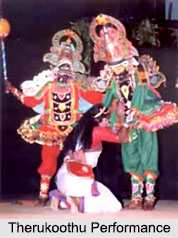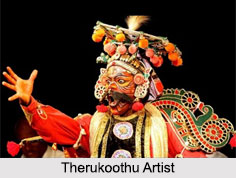 Therukoothu is a traditional street play of Tamil Nadu. The art of entertainment had reached to its peak in Tamil Nadu at an early age. There were mainly three forms of entertainment in ancient Tamil Nadu. These include the `iyal` (literature), `isai` (music) and `natagam` (drama). All these had their roots in the rural folk theatre like `therukoothu`, an energetic living theatre of Tamil Nadu. The term Therukoothu is derived from the Tamil words Teru means street and Kuttu means theatre. The art form `Therukoothu` is more popular in the northern districts of Tamil Nadu.
Therukoothu is a traditional street play of Tamil Nadu. The art of entertainment had reached to its peak in Tamil Nadu at an early age. There were mainly three forms of entertainment in ancient Tamil Nadu. These include the `iyal` (literature), `isai` (music) and `natagam` (drama). All these had their roots in the rural folk theatre like `therukoothu`, an energetic living theatre of Tamil Nadu. The term Therukoothu is derived from the Tamil words Teru means street and Kuttu means theatre. The art form `Therukoothu` is more popular in the northern districts of Tamil Nadu.
Time of Therukoothu Play
Therukoothu street play is generally organised in the villages of Tamil Nadu during the festivals in the months of `Panguni` i e, in March-April and Aadi i e, July-August. The Therukoothu play generally commences in the late evening and mostly concludes during the late hours of the nights.
Themes of Therukoothu
Therukoothu is generally performed on the base of the stories from great epics of India such as the Ramayana and Mahabharata- mostly common themes are Draupadi Kalyanam (The marriage of Draupadi), Supattirai Kalyanam (The marriage of Subhadra), Alli Arjunan (The Marriage of Arjuna with Alli), Pancal Capatam (The Vow of Draupadi), Arjunan Tapam (Arjuna`s tapas), Krishnan Titu (The mission of Krishna), Abhimanyu Cantai (The defeat of Abhimanyu), Karna Mokshayam (The defeat of Karna), Patinettam Por (The Battle of the Eighteenth Day), Aravan kalappali (Sacrifice of Aravan in the Battlefield) etc. Sometimes the stories from Tamil classics like Periya Puranam and Skanda Puranam are also taken to perform in Therukoothu.
 Performance of Therukoothu Play
Performance of Therukoothu Play
Therukoothu is generally performed at a place where three or four streets meet, in the open air. Before the performance starts, the place is lit up with gaslights. The singers and music troupe sit on the side on a bench. The performance consists of storytelling, dialogue rendering, songs and dance done by the artists.
Artists of Therukoothu Play
The artists themselves give the introduction of their roles. In the performance of Therukoothu, more importance is given to the songs and not to the dialogues. Therefore, the artists take formal training to sing in their own voice in a high pitch. They are also trained to deliver lengthy traditional dialogues. Male artists also perform the female roles.
Costumes of Therukoothu Play
According to the traditional system, only the male members can be seen in a Therukoothu troupe. It is organised mainly during the summer months when there is little agricultural work. The performers wear heavy costumes and make up. They put on high towering head dress, sparkling shoulder plates and wide colourful skirts. They put on elaborate make up which helps to deliver the performer"s expressions to the audience so that they can visualize the mythological characters in front of them. The orchestra of `Therukoothu` consists of a `mukhaveena`, a `mridhangam`, a harmonium and cymbals played by the natuvanar.




